Hungarian born film star Lya de Putti (1897-1931) portrayed vamps in German and American silent films. In 1925 she reached the zenith of her career with the leading role in the Weimar classic Variété, as the alluring femme fatale between Emil Jannings and Warwick Ward.

German postcard by Ross Verlag, Berlin, no. 1268/2, 1927-1928. Photo: Ufa. Lya de Putti in Varieté (Ewald André Dupont, 1925).

German postcard by Ross Verlag, Berlin, no. 1273/1, 1927-1928. Photo: Hans Natge.
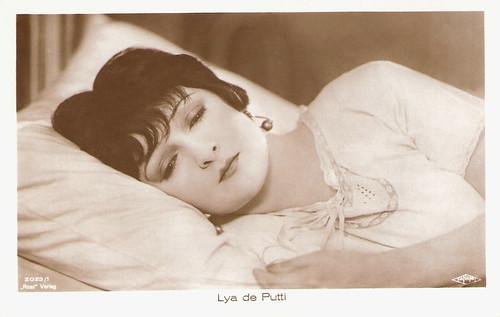
German postcard by Ross Verlag, no. 2023/1, 1927-1928. Photo: Fanam.
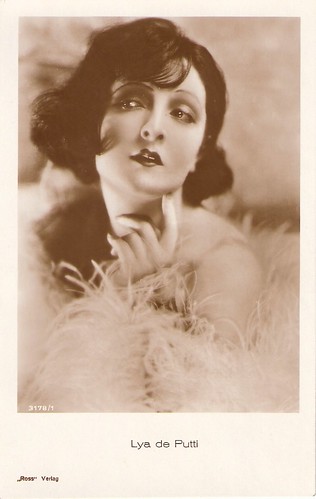
German postcard by Ross Verlag, no. 3178/1, 1928-1929. Photo: Roman Freulich.

German postcard by Ross Verlag, no. 3370/1, 1928-1929. Photo: Roman Freulich.

German postcard by Ross Verlag, Berlin, no. 727/2, 1925-1926. Photo: Alex Binder. Collection: Didier Hanson.
Amalia 'Lia' de Putty was born in Vécse, Austria-Hungary (now Vojcice, Slovakia) in 1897 (some sources say 1899). She was a daughter of a Hungarian baron and cavalry officer and a former countess. Lia had two brothers, Geza and Alexander, and a sister, Mitzi.
In 1913 (or 1912 according to some sources) she married county magistrate Zoltán Szepessy and she had two daughters with him.
In Budapest, she began her stage career with a short stint in the vaudeville circuit. In 1918 she made her screen debut with A császár katonái/The Emperor's soldiers (Béla Balogh, 1918).
That year she also divorced Szepessy. Shortly after her divorce she married Ludwig Christensen, who died in 1922.
She made her next film in Romania, Pe valurile fericirii/The waves of happiness (Dolly A. Szigethy, 1920). Then she moved on to the capital of the European silent cinema of the 1920s, Berlin.

French postcard by Edition de la Cinematographie Française. Photo: Grandes Productions Cinématographiques (G.P.C.). Photo: Ica von Lenkeffy as Desdemona and Lya de Putti as Emilia in Othello (Dimitri Buchowetzki, 1922).

French postcard by Edition de la Cinematographie Française. Photo: Grandes Productions Cinématographiques (G.P.C.). Photo: Werner Krauss as Jago and Lya de Putti as Emilia in Othello (Dimitri Buchowetzki, 1922).
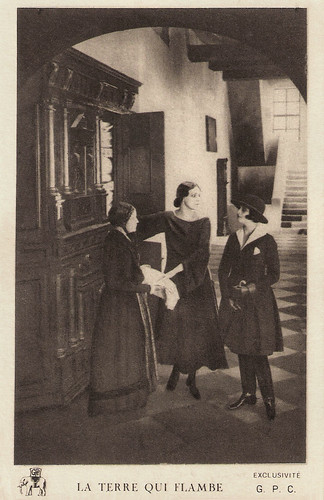
French postcard by Edition de la Cinématographie Française, Paris. Photo: G.P.C. Publicity still for Der brennende Acker/Burning Soil/La terre qui flambe (Friedrich Wilhelm Murnau, 1922). Helga, Count Rudenburg's second wife (Stella Arbenina), and Gerda, the Count's daughter (Lya de Putti), in a fierce get together.

French postcard by Edition de la Cinématographie Française, Paris. Photo: G.P.C. Publicity still for Der brennende Acker/Burning Soil/La terre qui flambe (Friedrich Wilhelm Murnau, 1922). Gerda (Lya de Putti) and her maid (Leonie Taliansky).
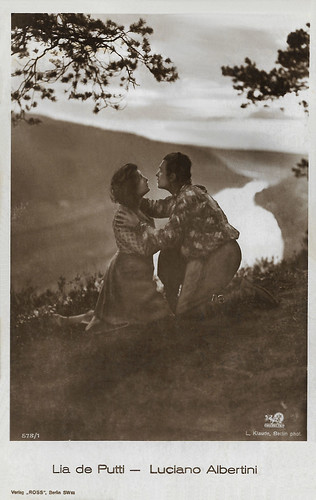
German postcard by Ross Verlag, Berlin, no. 578/1. Luciano Albertini and Lya de Putti in Die Schlucht des Todes (Luciano Albertini, Francis A. Bartoni, 1923). The card depicts the final scene: Luciano has just saved Lya from falling down the Devil's Canyon and reconciles with her after his refusal to acknowledge her illegal child and his failed attempt to suicide.
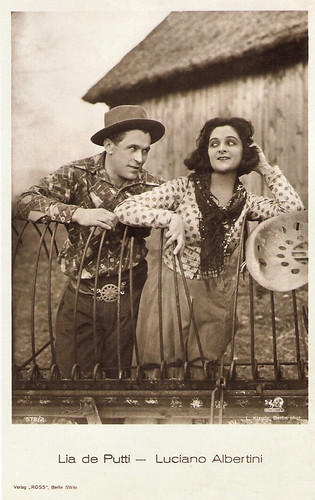
German postcard by Ross Verlag, Berlin, no. 578/2, 1919-1924. Photo: Leo Klaude, Berlin / Phoebus Film. Luciano Albertini and Lya de Putti in Die Schlucht des Todes/The Ravine of Death (Luciano Albertini, Albert-Francis Bertoni, Max Obal, 1923).
In 1920, Lya de Putti progressed to perform classical ballet in Berlin. She became the premiere danseuse at the Berlin Winter Garden in 1924.
In Germany she played supporting roles in films by famous directors. She worked twice with F.W. Murnau, first at the drama Die brennende Acker/Burning Soil (1921) with Vladimir Gajdarov, and then at Phantom (1922) starring Alfred Abel.
She starred in six films produced by Joe May, including the exotic adventure epic Das Indische Grabmal/The Indian Tomb (Joe May, 1921) starring Olaf Fønss.
Her biggest hit – especially in the US – was the UFA production Varieté/Jealousy (Ewald André Dupont, 1925). De Putti played the alluring femme fatale Bertha-Marie, who seduces the simple carnival concessionaire Stephan Huller (Emil Jannings) and then betrays him with the handsome acrobat (Warwick Ward). Feeling doubly impotent because he himself had been a famous aerialist before suffering a crippling accident, Jannings fantasises about killing his rival - and, finally, does so.
De Putti followed this success with star performances in Manon Lescaut (Arthur Robison, 1925) opposite Vladimir Gajdarov, and Junges Blut/Young Blood (Manfred Noa, 1926) with Walter Slezak.
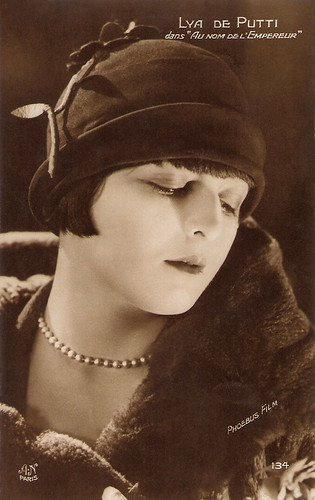
French postcard by A.N., Paris, no. 134. Photo: Phoebus Film. Publicity still for Im Namen des Kaisers/In the Name of the Emperor (Robert Dinesen, 1925).

German postcard by Ross Verlag, Berlin, no. 868/1, 1925-1926. Photo: Binder. Collection Didier Hanson. Early card of De Putti in which her name is still spelled Lia instead of Lya.
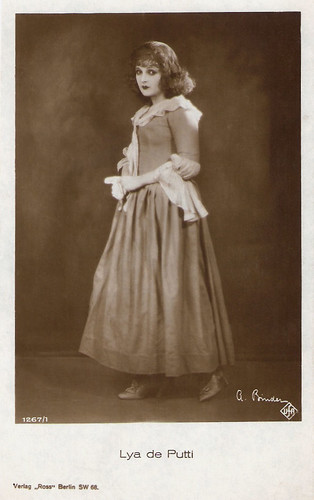
German postcard by Ross Verlag, Berlin, no. 1267/1, 1927-1928. Photo: Alex Binder / Ufa. Lya de Putti in Manon Lescaut (Arthur Robison, 1926).

German postcard by Ross Verlag, Berlin, no. 1267/2, 1927-1928. Photo: Alex Binder / Ufa. Lya de Putti in Manon Lescaut (Arthur Robison, 1926).

Italian postcard by G.B. Falci, Milano, no. 129. Photo: A. Stefano Pittaluga. Lya de Putti and Vladimir Gajdarov in Manon Lescaut (Arthur Robison, 1926).
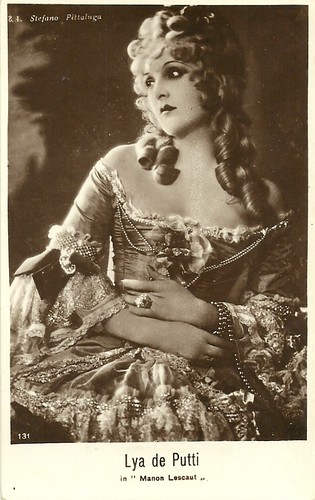
Italian postcard by S.A. Stefano Pittaluga, no. 131. Photo: Lya de Putti in Manon Lescaut (Arthur Robison, 1926).
Studio mogul Adolph Zukor invited Lya de Putti to come to Hollywood.
At her arrival in New York in February 1926, she told American reporters that she was twenty-two years old. Her ocean liner's records list her as having been twenty-six.
Her American debut was David Wark Griffith's Sorrows of Satan (D.W. Griffith, 1926) starring Adolphe Menjou. The film was released in two versions, one in America and the other in Europe. In the American version one scene had De Putti fully dressed. The same scene in the European release had De Putti topless.
She went to work for Universal in such films as The Heart Thief (Nils Olaf Chrisander, 1927) starring Joseph Schildkraut, Buck Privates (Melville W. Brown, 1928) with Zasu Pitts, and The Scarlet Lady (Alan Crosland, 1928).
In between these films she returned to Germany for a short time in order to shoot Charlotte etwas verrückt/Charlott something crazy (Adolf E. Licho, 1928). During this stay a serious accident happened. Lya de Putti fell down from a window. The press interpreted it as an attempted suicide. But de Putti recovered quickly and returned to the US.
Hollywood generally casted her as a vamp, and she often wore her dark hair short in a style similar to that of Louise Brooks.

German postcard by Ross Verlag, Berlin, no. 1028/1, 1927-1928. Photo: Alex Binder.

German postcard by Ross Verlag, Berlin, no. 1028/2, 1927-1928. Photo: Alex Binder.

German postcard by Ross Verlag, Berlin, no. 1028/3, 1927-1928. Photo: Alex Binder.
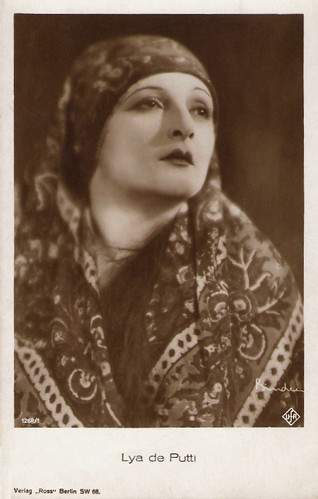
German postcard by Ross Verlag, Berlin, no. 1268/1, 1927-1928. Photo: Alex Binder / Ufa.
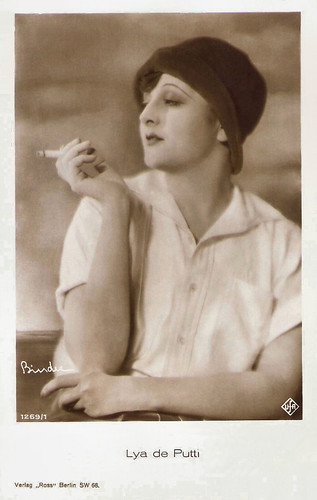
German postcard by Ross Verlag, Berlin, no. 1269/1, 1927-1928. Photo: Alex Binder / Ufa.
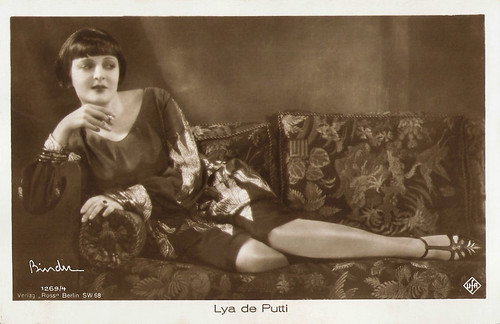
German postcard by Ross Verlag, Berlin, no. 1269/4, 1927-1928. Photo: Alex Binder / Ufa.
Lya de Putti was rumored to be engaged to Count Ludwig Salm von Hoogstraten, a former husband of the American oil heiress Millicent Rogers, but she denied the engagement.
De Putti failed to make it big in Hollywood and her Hollywood efforts were inhibited by her foreign accent when the sound film arrived.
She left the screen by 1929 to attempt to make a re-start on Broadway. Later that year she returned to Europe.
In Germany, she could be seen in Rund um die Liebe/About Love (Oskar Kalbus, 1929), a documentary compilation film showing footage from various films with a.o. Lilian Harvey and Valerie Boothby.
She went to England to study the language and also made there the silent film The Informer (Arthur Robison, 1929) with Lars Hanson and Warwick Ward. It would turn out to be her final film.

German postcard by Ross Verlag, Berlin, no. 1273/2, 1927-1928. Photo: Hans Natge.
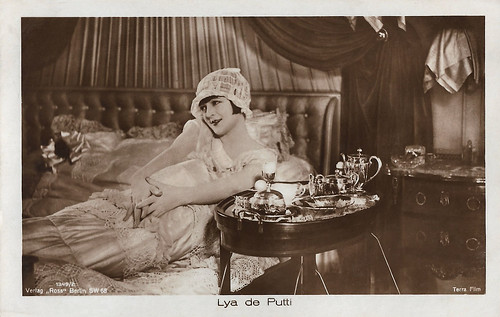
German postcard by Ross Verlag, Berlin, no. 1349/2, 1927-1928. Photo: Terra Film. Lya de Putti in Junges Blut/Young Blood (Manfred Noa, 1926).

German postcard by Ross Verlag, Berlin, no. 1350/1, 1927-1928. Photo: Terra Film. Walter Slezak and Lya de Putti in Junges Blut/Young Blood (Manfred Noa, 1926).

German postcard by Ross Verlag, Berlin, no. 1562/3, 1927-1928. The signature of the photographer could be "Freimuth", but also "Lutteroth", a photographer in Munich whose work was used by Ross, or "Kurzrock", a photographer from Wiesbaden whose work Ross also used.

German postcard by Ross Verlag, Berlin, no. 1819/4, 1927-1928. Photo: Fanam.

German postcard by Ross Verlag, no. 1931/2, 1927-1928. Photo: Melbourne Spurr, Hollywood.
Lya de Putti returned to America. At the end of 1931 followed a macabre and bizarre accident. De Putti swallowed a chicken bone which had to be surgically removed.
At the hospital, she reportedly behaved irrationally and eluded her nurses. Eventually she was found in a corridor. She contracted an infection, then pleurisy in her right side, followed by pneumonia in both lungs.
Lya de Putti died in 1931 in the New York hospital. She was only 34.
According to Wikipedia, she left "just £800 (UK equivalent at the time) and a few bits of jewellery. Four years earlier, £800 was her weekly wage."
She was survived by her third husband, Louis Jahnke, whom she had married in 1922. Her first husband, Zoltán Szepessy, committed suicide shortly after her death.
They had two daughters, Ilona (1914) and Judith (1916). Both daughters were interviewed as old ladies for the documentary Das dritte Leben der Lya de Putti/The Third Life of Lya de Putti (Gisela Scheelein, 1996).
In the film Cabaret (Bob Fosse, 1972), singer Sally Bowles (Liza Minnelli) tells her friend Brian Roberts (Michael York) that Lya de Putti is her 'favourite screen siren'. In a subsequent scene, Bowles dismisses de Putti, claiming that she "makes too many faces."

German postcard by Ross Verlag, Berlin, no. 3020/3, 1928-1929.
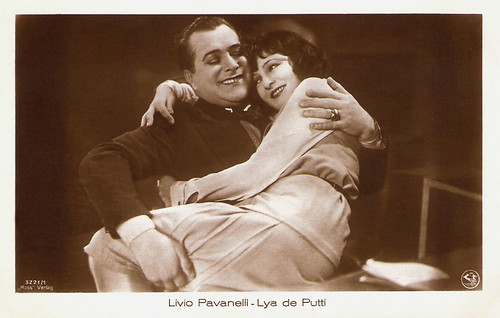
German postcard by Ross Verlag, no. 3221/1, 1928-1929. Photo: Phoebus-Film AG. Livio Pavanelli and Lya de Putti in the German silent film Charlott etwas verrückt/Charlott a little crazy (Adolf E. Licho, 1929).

German postcard by Ross Verlag, Berlin, Foreign, no. 3452, 1928-1929. Photo: G.L. Manuel Frères, Paris.

German postcard by Ross Verlag, no. 3494/2, 1928-1929. Photo: probably a still from The Heart Thief (Nils Olaf Chrisander, 1927).

German postcard by Ross Verlag, no. 3495/1, 1928-1929. Photo: LPG. Lya de Putti and Joseph Schildkraut in The Heart Thief (Nils Olaf Chrisander, 1927).

German postcard by Ross Verlag, Berlin, no. 3817/3, 1928-1929.
Sources: Hal Erickson (AllMovie), Jessica Keaton (Silence is Golden), Thomas Staedeli (Cyranos), Jarod Hitching (IMDb), Wikipedia, Filmportal.de and IMDb.

German postcard by Ross Verlag, Berlin, no. 1268/2, 1927-1928. Photo: Ufa. Lya de Putti in Varieté (Ewald André Dupont, 1925).

German postcard by Ross Verlag, Berlin, no. 1273/1, 1927-1928. Photo: Hans Natge.

German postcard by Ross Verlag, no. 2023/1, 1927-1928. Photo: Fanam.

German postcard by Ross Verlag, no. 3178/1, 1928-1929. Photo: Roman Freulich.

German postcard by Ross Verlag, no. 3370/1, 1928-1929. Photo: Roman Freulich.

German postcard by Ross Verlag, Berlin, no. 727/2, 1925-1926. Photo: Alex Binder. Collection: Didier Hanson.
To the capital of the European silent cinema of the 1920s
Amalia 'Lia' de Putty was born in Vécse, Austria-Hungary (now Vojcice, Slovakia) in 1897 (some sources say 1899). She was a daughter of a Hungarian baron and cavalry officer and a former countess. Lia had two brothers, Geza and Alexander, and a sister, Mitzi.
In 1913 (or 1912 according to some sources) she married county magistrate Zoltán Szepessy and she had two daughters with him.
In Budapest, she began her stage career with a short stint in the vaudeville circuit. In 1918 she made her screen debut with A császár katonái/The Emperor's soldiers (Béla Balogh, 1918).
That year she also divorced Szepessy. Shortly after her divorce she married Ludwig Christensen, who died in 1922.
She made her next film in Romania, Pe valurile fericirii/The waves of happiness (Dolly A. Szigethy, 1920). Then she moved on to the capital of the European silent cinema of the 1920s, Berlin.

French postcard by Edition de la Cinematographie Française. Photo: Grandes Productions Cinématographiques (G.P.C.). Photo: Ica von Lenkeffy as Desdemona and Lya de Putti as Emilia in Othello (Dimitri Buchowetzki, 1922).

French postcard by Edition de la Cinematographie Française. Photo: Grandes Productions Cinématographiques (G.P.C.). Photo: Werner Krauss as Jago and Lya de Putti as Emilia in Othello (Dimitri Buchowetzki, 1922).

French postcard by Edition de la Cinématographie Française, Paris. Photo: G.P.C. Publicity still for Der brennende Acker/Burning Soil/La terre qui flambe (Friedrich Wilhelm Murnau, 1922). Helga, Count Rudenburg's second wife (Stella Arbenina), and Gerda, the Count's daughter (Lya de Putti), in a fierce get together.

French postcard by Edition de la Cinématographie Française, Paris. Photo: G.P.C. Publicity still for Der brennende Acker/Burning Soil/La terre qui flambe (Friedrich Wilhelm Murnau, 1922). Gerda (Lya de Putti) and her maid (Leonie Taliansky).

German postcard by Ross Verlag, Berlin, no. 578/1. Luciano Albertini and Lya de Putti in Die Schlucht des Todes (Luciano Albertini, Francis A. Bartoni, 1923). The card depicts the final scene: Luciano has just saved Lya from falling down the Devil's Canyon and reconciles with her after his refusal to acknowledge her illegal child and his failed attempt to suicide.

German postcard by Ross Verlag, Berlin, no. 578/2, 1919-1924. Photo: Leo Klaude, Berlin / Phoebus Film. Luciano Albertini and Lya de Putti in Die Schlucht des Todes/The Ravine of Death (Luciano Albertini, Albert-Francis Bertoni, Max Obal, 1923).
An alluring femme fatale
In 1920, Lya de Putti progressed to perform classical ballet in Berlin. She became the premiere danseuse at the Berlin Winter Garden in 1924.
In Germany she played supporting roles in films by famous directors. She worked twice with F.W. Murnau, first at the drama Die brennende Acker/Burning Soil (1921) with Vladimir Gajdarov, and then at Phantom (1922) starring Alfred Abel.
She starred in six films produced by Joe May, including the exotic adventure epic Das Indische Grabmal/The Indian Tomb (Joe May, 1921) starring Olaf Fønss.
Her biggest hit – especially in the US – was the UFA production Varieté/Jealousy (Ewald André Dupont, 1925). De Putti played the alluring femme fatale Bertha-Marie, who seduces the simple carnival concessionaire Stephan Huller (Emil Jannings) and then betrays him with the handsome acrobat (Warwick Ward). Feeling doubly impotent because he himself had been a famous aerialist before suffering a crippling accident, Jannings fantasises about killing his rival - and, finally, does so.
De Putti followed this success with star performances in Manon Lescaut (Arthur Robison, 1925) opposite Vladimir Gajdarov, and Junges Blut/Young Blood (Manfred Noa, 1926) with Walter Slezak.

French postcard by A.N., Paris, no. 134. Photo: Phoebus Film. Publicity still for Im Namen des Kaisers/In the Name of the Emperor (Robert Dinesen, 1925).

German postcard by Ross Verlag, Berlin, no. 868/1, 1925-1926. Photo: Binder. Collection Didier Hanson. Early card of De Putti in which her name is still spelled Lia instead of Lya.

German postcard by Ross Verlag, Berlin, no. 1267/1, 1927-1928. Photo: Alex Binder / Ufa. Lya de Putti in Manon Lescaut (Arthur Robison, 1926).

German postcard by Ross Verlag, Berlin, no. 1267/2, 1927-1928. Photo: Alex Binder / Ufa. Lya de Putti in Manon Lescaut (Arthur Robison, 1926).

Italian postcard by G.B. Falci, Milano, no. 129. Photo: A. Stefano Pittaluga. Lya de Putti and Vladimir Gajdarov in Manon Lescaut (Arthur Robison, 1926).

Italian postcard by S.A. Stefano Pittaluga, no. 131. Photo: Lya de Putti in Manon Lescaut (Arthur Robison, 1926).
Invitation to Hollywood
Studio mogul Adolph Zukor invited Lya de Putti to come to Hollywood.
At her arrival in New York in February 1926, she told American reporters that she was twenty-two years old. Her ocean liner's records list her as having been twenty-six.
Her American debut was David Wark Griffith's Sorrows of Satan (D.W. Griffith, 1926) starring Adolphe Menjou. The film was released in two versions, one in America and the other in Europe. In the American version one scene had De Putti fully dressed. The same scene in the European release had De Putti topless.
She went to work for Universal in such films as The Heart Thief (Nils Olaf Chrisander, 1927) starring Joseph Schildkraut, Buck Privates (Melville W. Brown, 1928) with Zasu Pitts, and The Scarlet Lady (Alan Crosland, 1928).
In between these films she returned to Germany for a short time in order to shoot Charlotte etwas verrückt/Charlott something crazy (Adolf E. Licho, 1928). During this stay a serious accident happened. Lya de Putti fell down from a window. The press interpreted it as an attempted suicide. But de Putti recovered quickly and returned to the US.
Hollywood generally casted her as a vamp, and she often wore her dark hair short in a style similar to that of Louise Brooks.

German postcard by Ross Verlag, Berlin, no. 1028/1, 1927-1928. Photo: Alex Binder.

German postcard by Ross Verlag, Berlin, no. 1028/2, 1927-1928. Photo: Alex Binder.

German postcard by Ross Verlag, Berlin, no. 1028/3, 1927-1928. Photo: Alex Binder.

German postcard by Ross Verlag, Berlin, no. 1268/1, 1927-1928. Photo: Alex Binder / Ufa.

German postcard by Ross Verlag, Berlin, no. 1269/1, 1927-1928. Photo: Alex Binder / Ufa.

German postcard by Ross Verlag, Berlin, no. 1269/4, 1927-1928. Photo: Alex Binder / Ufa.
An attempt to make a re-start on Broadway
Lya de Putti was rumored to be engaged to Count Ludwig Salm von Hoogstraten, a former husband of the American oil heiress Millicent Rogers, but she denied the engagement.
De Putti failed to make it big in Hollywood and her Hollywood efforts were inhibited by her foreign accent when the sound film arrived.
She left the screen by 1929 to attempt to make a re-start on Broadway. Later that year she returned to Europe.
In Germany, she could be seen in Rund um die Liebe/About Love (Oskar Kalbus, 1929), a documentary compilation film showing footage from various films with a.o. Lilian Harvey and Valerie Boothby.
She went to England to study the language and also made there the silent film The Informer (Arthur Robison, 1929) with Lars Hanson and Warwick Ward. It would turn out to be her final film.

German postcard by Ross Verlag, Berlin, no. 1273/2, 1927-1928. Photo: Hans Natge.

German postcard by Ross Verlag, Berlin, no. 1349/2, 1927-1928. Photo: Terra Film. Lya de Putti in Junges Blut/Young Blood (Manfred Noa, 1926).

German postcard by Ross Verlag, Berlin, no. 1350/1, 1927-1928. Photo: Terra Film. Walter Slezak and Lya de Putti in Junges Blut/Young Blood (Manfred Noa, 1926).

German postcard by Ross Verlag, Berlin, no. 1562/3, 1927-1928. The signature of the photographer could be "Freimuth", but also "Lutteroth", a photographer in Munich whose work was used by Ross, or "Kurzrock", a photographer from Wiesbaden whose work Ross also used.

German postcard by Ross Verlag, Berlin, no. 1819/4, 1927-1928. Photo: Fanam.

German postcard by Ross Verlag, no. 1931/2, 1927-1928. Photo: Melbourne Spurr, Hollywood.
A fatal chicken bone
Lya de Putti returned to America. At the end of 1931 followed a macabre and bizarre accident. De Putti swallowed a chicken bone which had to be surgically removed.
At the hospital, she reportedly behaved irrationally and eluded her nurses. Eventually she was found in a corridor. She contracted an infection, then pleurisy in her right side, followed by pneumonia in both lungs.
Lya de Putti died in 1931 in the New York hospital. She was only 34.
According to Wikipedia, she left "just £800 (UK equivalent at the time) and a few bits of jewellery. Four years earlier, £800 was her weekly wage."
She was survived by her third husband, Louis Jahnke, whom she had married in 1922. Her first husband, Zoltán Szepessy, committed suicide shortly after her death.
They had two daughters, Ilona (1914) and Judith (1916). Both daughters were interviewed as old ladies for the documentary Das dritte Leben der Lya de Putti/The Third Life of Lya de Putti (Gisela Scheelein, 1996).
In the film Cabaret (Bob Fosse, 1972), singer Sally Bowles (Liza Minnelli) tells her friend Brian Roberts (Michael York) that Lya de Putti is her 'favourite screen siren'. In a subsequent scene, Bowles dismisses de Putti, claiming that she "makes too many faces."

German postcard by Ross Verlag, Berlin, no. 3020/3, 1928-1929.

German postcard by Ross Verlag, no. 3221/1, 1928-1929. Photo: Phoebus-Film AG. Livio Pavanelli and Lya de Putti in the German silent film Charlott etwas verrückt/Charlott a little crazy (Adolf E. Licho, 1929).

German postcard by Ross Verlag, Berlin, Foreign, no. 3452, 1928-1929. Photo: G.L. Manuel Frères, Paris.

German postcard by Ross Verlag, no. 3494/2, 1928-1929. Photo: probably a still from The Heart Thief (Nils Olaf Chrisander, 1927).

German postcard by Ross Verlag, no. 3495/1, 1928-1929. Photo: LPG. Lya de Putti and Joseph Schildkraut in The Heart Thief (Nils Olaf Chrisander, 1927).

German postcard by Ross Verlag, Berlin, no. 3817/3, 1928-1929.
Sources: Hal Erickson (AllMovie), Jessica Keaton (Silence is Golden), Thomas Staedeli (Cyranos), Jarod Hitching (IMDb), Wikipedia, Filmportal.de and IMDb.
2 comments:
What's wrong with her nose?
I know it is strange to see a movie star without a nose job but these were old movies. Before that.
Post a Comment